Investing.com - Gold drifted slightly higher in Asia with some attention shifting to a tense Himalayan standoff between India and China who fought a brief, but bloody border war over the territory in 1962.
Gold futures for December delivery on the Comex division of the New York Mercantile Exchange inched up 0.02% to $1.292.57 a troy ounce.
India and China, the world's top two gold buyers, started a standoff two months ago when Indian troops confronted Chinese forces working on a road over the Doklam Plateau, a strategically important area near where Tibet, India and Bhutan meet, and which both China and Bhutan – an ally of India – claim as their own.
Overnight, gold prices traded near session highs on Thursday after the minutes of the Federal Reserve’s July meeting showed members were concerned about raising interest rates amid a slowdown in inflation, narrowing investor expectations for a third rate hike later this year.
The minutes of the Fed's July 25-26 policy meeting on Wednesday, showed some policymakers believed the Fed could afford to stand pat on further rate increases until it is clear the trend of soft inflation is transitory.
The somewhat dovish minutes, dampened investor expectations of third rate hike later this year, underpinning a move higher in gold futures.
Gold is sensitive to moves in U.S. rates, which lift the opportunity cost of holding non-yielding assets such as bullion.
Gold futures, however, struggled to breach $1,300 as initial jobless claims and manufacturing data topped forecasts, lifting sentiment on the strength of the U.S. economy.
Initial claims for state unemployment benefits dropped 12,000 to a seasonally adjusted 232,000 for the week ended Aug. 12, the Labor Department said. That beat economists’ forecasts of a just 4,000 decline.
In a separate report, the Federal Reserve bank of Philadelphia said that its Philly Fed manufacturing index rose to a seasonally adjusted 18.9 for August, compared with consensus estimates of 18.5.
The upbeat economic reports lifted the dollar against its rivals, capping gains in dollar-denominated commodities.
